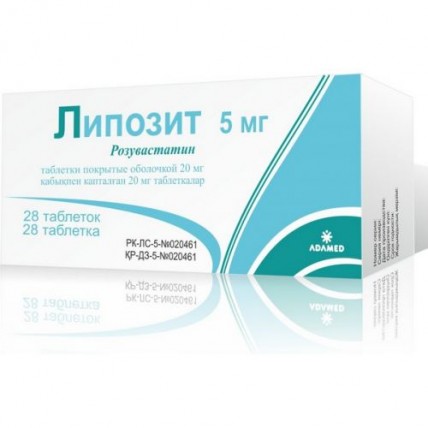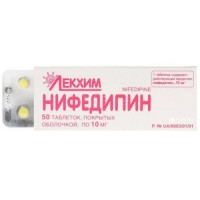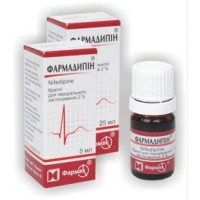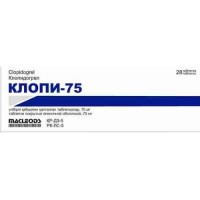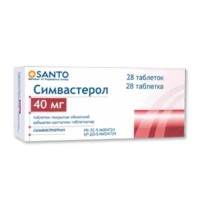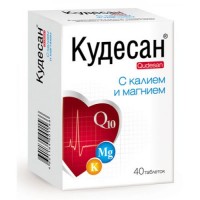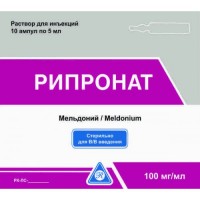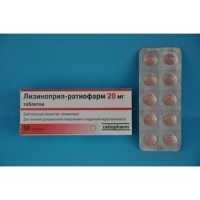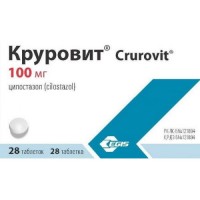Liposomes 28's 5 mg coated tablets
- $14.60
Instruction for medical use of Lipozit Torgovoye medicine name of Lipozit International unlicensed name Rosuvastatin Dosage Form of the Tablet, coated, 5 mg, 10 mg, 20 mg and 40 mg. Structure One tablet contains active agent of Rosuvastatin of calcium, in mg: (it is equivalent to rosuvastatin) 5.2000 (5.000) 10.4000 (10.000) 20.8000 (20.000) 41.6000 (40.000) excipients: cellulose microcrystalline (type 102), lactoses monohydrate dry, krospovidon (type A), magnesium stearate structure of a film cover: lactoses monohydrate, gipromelloz (E464), titan of dioxide (E 171), triacetin (E1518), aluminum varnish quinolinic yellow (E 104). The description of the Tablet of round shape, with a biconvex surface, coated yellowish color, with an engraving 5 on one party and- on other party, with a diameter of 6 mm (for a dosage of 5 mg). Tablets of round shape, with a biconvex surface, coated yellowish color, with an engraving 10 on one party and- on other party, with a diameter of 7 mm (for a dosage of 10 mg). Tablets of round shape, with a biconvex surface, coated yellowish color, with an engraving 20 on one party and- on other party, with a diameter of 9 mm (for a dosage of 20 mg). Tablets of round shape, with a biconvex surface, coated yellowish color, with an engraving 40 on one party and- on other party, with a diameter of 10 mm (for a dosage of 40 mg). Pharmacotherapeutic group Hypolipidemic drugs. Gipokholesterinemichesky and gipotriglitseridemichesky drugs. Reductase HMG SoA inhibitors. Rosuvastatin. ATX C10A A07 code Pharmacological Pharmacokinetics Absorption properties: after rosuvastatin intake the maximum concentration in plasma is reached approximately in 5 hours. The absolute bioavailability is about 20%. Distribution: rosuvastatin is substantially distributed in a liver, in principal organ of synthesis of cholesterol and utilization of H-LPNP. The volume of distribution of rosuvastatin is about 134 l. About 90% of rosuvastatin contact proteins of plasma, mainly, with albumine. Metabolism: rosuvastatin is metabolized in small degree (10%). The main found metabolites are derivative N-dimetila and a lactone, derivative N-dimetila for 50% are less active, than rosuvastatin, and derivatives of a lactone are considered clinically not as active. Rosuvastatin brakes more than 90% of activity of HMG SoA of reductase. Removal: about 90% of rosuvastatin are allocated in an invariable view with a stake (irrespective of, the absorbed and not absorbed rosuvastatin). The rest is allocated with urine. About 5% are allocated in an invariable view with urine. The half-life period in a phase of elimination is about 19 hours. At increase in a dose the half-life period in a phase of elimination does not increase. The average clearance of plasma is about 50 l/h (coefficient of variations of 21.7%). Also as well as with other inhibitors of HMG SoA reductase, rosuvastatin absorption by cells of a liver is carried out by means of a transport protein From organic anions (OATP-C). This connection is important in the course of elimination of rosuvastatin in a liver. Linearity: system effects of rosuvastatin increase in proportion to a dosage. At multiple dose within a day pharmacokinetic parameters do not change. Pharmacodynamics action Mechanism: Rosuvastatin is a selective and effective inhibitor of HMG SoA reductase, enzyme of the transformation of a 3-hydroxy-3-metiloglutaril-coenzyme accelerating process And in mevalonat - the predecessor of cholesterol. Rosuvastatin increases the number of receptors for LLD (lipoproteids of low density) (bad cholesterol or beta lipoproteids) by surfaces of cells of a liver that facilitates involvement of LNP in catabolism, suppresses synthesis of LPONP in a liver that leads to reduction of total number of LNP and LPONP (lipoproteids of very low density). Rosuvastatin reduces the increased content of cholesterol-LDL, general cholesterol, triglycerides (TG), increases cholesterol content - lipoproteins of the high density (HS-LPVP). It also reduces apolipoprotein B content (ApoV), Hs-neLPVP (content of the general cholesterol minus LPVP cholesterol content), HS-LPONP, TG-LPONP and increases the level of A-I apolipoprotein (ApoA-I). Rosuvastatin reduces ratio Hs-LPNP/HS-LPVP, the general Hs/Hs-LPVP, Hc-neLPVP/Hs-LPVP and ApoV/ApoA-I. The therapeutic effect is reached within 1 week from an initiation of treatment, and within 2 weeks 90% effect are reached. The maximum therapeutic effect is reached within 4 weeks and further is maintained at this level. Clinical performance. Rosuvastatin is effective at adult patients with the hypercholesterolemia appearing together with a gipertriglitseridemiya or without it irrespective of race, a sex, age and also among special groups of the patients, for example, having diabetes and a hereditary hypercholesterolemia. Indications additional therapy to a diet at primary hypercholesterolemia (IIa type) or the mixed dislipidemiya (IIb type) when use of a diet and other non-drug methods of treatment (physiotherapy exercises, decrease in body weight) is insufficient additional therapy to a diet and to other methods of treatment lowering the level of lipids at a family homozygous hypercholesterolemia (for example, an afereza of LDL (lipoproteids of low density)) or when other ways of treatment are inefficient as addition to a diet for delay of progressing of atherosclerosis at adult patients as a part of therapy for decrease in level of the LPNP general cholesterol (OHS) and XC to target level. A route of administration and doses Inside, at any time irrespective of meal. Before a course of treatment and during treatment the patient has to adhere to the diet directed to reduction of amount of cholesterol. The dosage needs to be established individually, according to obligatory recommendations: depending on the therapy purpose and also from reaction of the patient to treatment. The recommended initial dose makes 5 or 10 mg of times a day as to the patients who were earlier not taking the drugs of group of statines (hypolipidemic means) reducing cholesterol level, and treated by other inhibitors of HMG SoA reductase. During definition of an initial dose it is necessary to take into account cholesterol level at the specific patient and risk of appearance in the future of cardiovascular diseases and also risk of emergence of side effects. If this condition is satisfied, then 4 weeks of treatment later the dose can be increased. Due to the increase in frequency of side effects after increase in a dose of drug up to 40 mg, in comparison with consequences from use of smaller dosages, increase in a dose up to the maximum dose in 40 mg can be applied only at patients with the high content of cholesterol relating to group of high risk of a disease of cardiovascular diseases (especially to patients with hereditarily high content of cholesterol) at which the expected treatment goal after use of a dose of 20 mg is not achieved. The patients applying a dosage in 40 mg have to be under control of the expert. Patients at advanced age: the recommended initial dosage to patients aged is more senior than 70 years makes 5 mg. There is no need of change of a dosage of drug for patients of other age categories. Patients with a renal failure: for patients without acute and chronic renal failure of need for change of a dose there is no drug. The recommended initial dose to patients with a renal failure (clearance of creatinine less than 60 ml/min.) makes 5 mg. Use of a dose of 40 mg is contraindicated to patients with small renal failures. Use of the drug Lipozit is contraindicated also to patients with heavy renal failures (clearance of creatinine less than 30 ml/min.). Patients with a liver failure: the strengthened reaction of an organism to rosuvastatin at patients with 7 points or the smaller number of points on a scale of Chayld-Pyyu is not revealed. However at patients with 8 or 9 points on a scale of Chayld-Pyyu the increase in exposure of influence of rosuvastatin was observed. At such patients it is necessary to estimate work of kidneys. Any data concerning use of drug at patients with more than 9 points on a scale of Chayld-Pyyu no. Use of the drug Lipozit is contraindicated to patients with a liver failure. Patients of various race: at patients of Asian origin the increased reaction of an organism to rosuvastatin was observed. For patients of Asian origin the recommended initial dose makes 5 mg. Use of a dose of 40 mg is contraindicated to such patients. The patients predisposed to a myopathy: prescribing of drug in a dose of 40 mg is contraindicated to patients with the factors predisposed to development of a myopathy. The recommended initial dose for this group of patients makes 5 mg. The accompanying therapy. Rosuvastatin represents substrate of various proteins carriers (for example, transport polypeptide of organic anions 1B1 and squirrels of resistance of a breast cancer). The risk of a myopathy (including acute necrosis of skeletal muscles) increases when rosuvastatin is appointed together with certain medications which can increase concentration of rosuvastatin in plasma, as a result of interactions with these proteins carriers (for example, cyclosporine and certain inhibitors of protease, including combinations of a ritonavir with atazanaviry, lopinaviry and/or tipranaviry). At an opportunity it is necessary to see alternative drugs and, if necessary, temporarily to stop therapy by rosuvastatin. In situations where combined use of these medications with rosuvastatin is inevitable, it is necessary to consider carefully advantages and risk of the accompanying therapy and regulation of a dosage of rosuvastatin. Side effects the Frequency of emergence of side effects is formulated as follows: appearing very often (& gt, 1/10), it is frequent (& gt, 1/100, & lt, 1/10), is not really frequent (& gt, 1/1000, & lt, 1/100), is rare (& gt, 1/10,000, & lt, 1/1000), is very rare (& lt, 1/10,000), it is unknown (when it is impossible to determine frequency on the basis of the available data). Often (& gt, 1/100 to & lt, 1/10) a headache, dizziness nausea, a constipation, an abdominal pain myalgia an asthenia diabetes of the II type muscle pain Infrequently (≥ 1/1000 to & lt, 1/100) an itching, rash and urticaria Seldom (& gt, 1/10,000, & lt, 1/1,000) hypersensitivity reactions, including a Quincke's disease a myopathy (including a miositis) and a rhabdomyolysis increase in level of hepatic transaminases, pancreatitis Very seldom (& lt, 1/10,000) jaundice, hepatitis polyneuropathy memory loss a hamaturia, an arthralgia proteinuria a depression, sleep disorders sexual dysfunction Isolated cases interstitial diseases of lungs of not specified frequency diarrhea the immunomediated necrotizing myopathy cough, short wind Stephens-Johnson's syndrome a gynecomastia peripheral hypostases As well as in cases with other inhibitors of HMG SoA reductase the frequency of side effects depends on a dosage of this drug. A proteinuria, especially proteinurias of the canalicular mechanism of origin with the accompanying sand weight. During treatment by doses of 10 mg or 20 mg less than at 1% of patients and at 3% of patients (at a dose in 40 mg) change of amount of protein in urine is revealed: from result is absent or traces to the ++ level. In most cases the proteinuria decreases or disappears in the course of therapy and does not mean emergence sharp or progressing of the existing disease of the kidneys, At small group receiving rosuvastatin of patients as well as in a case using other HMG SoA inhibitors, increase in activity of aminotransferases depending on a drug dose was found. And in most cases it was acceptable, asymptomatic and temporary, the Frequency of appearance of a rhabdomyolysis, heavy side effects from kidneys and a liver (increase in activity of transaminases) increases at a dosage in 40 mg. Contraindications hypersensitivity to rosuvastatin or to any of drug ingredients, existing (and also not revealed yet) a liver disease, with long superactivity of serumal aminotransferases and with exceeding the upper bound of standard of activity of one of them by 3 times, heavy renal failures (clearance of creatinine less than 30 ml/min.), a myopathy, a concomitant use of cyclosporine, hereditary intolerance of a galactose, a lactose intolerance or a sprue of glucose and a galactose pregnancy, the lactation period, reproductive age (without use of reliable means of contraception), children's and teenage age up to 18 years. Use of drug of a dose of 40 mg is contraindicated to patients with the factors contributing to a myopathy or a rhabdomyolysis. Treat such factors: the moderate renal failure (clearance of creatinine less than 60 ml/min.), a hypothyroidism, is hereditary the caused disease of muscle tissue at the patient or in the anamnesis, emergence of symptoms of aggravation of symptoms of muscle tissue after use of other inhibitor of HMG SoA reductase, a state which can lead to increase in concentration of rosuvastatin in blood, simultaneous use of fibrat, an alcohol abuse, to patients of Asian race the age is more senior than 70 years thrombocytopenia Medicinal interactions Cyclosporine. Simultaneous use of rosuvastatin and cyclosporine leads to 7-fold increase in the area under a curve (AUC) of rosuvastatin in comparison with the upper bound of norm, unlike healthy examinees. Simultaneous use does not affect concentration of cyclosporine in plasma. Antagonists of vitamin K. Also, as well as in a case using other inhibitors of HMG SoA reductase, at the beginning or during treatment the increase in a dose of rosuvastatin at the patients who are at the same time treated antagonists of vitamin K (for example, warfarin or other anticoagulants of group of coumarin), can be observed increase in the International Normalized Ratio (INR). Reduction of a dose of drug of rosuvastatin or suspension of its use can lead to decrease in the Ministry of Taxes and Tax Collection. In such cases it is necessary to control the Ministry of Taxes and Tax Collection carefully. Gemfibrozil and other drugs reducing concentration of lipids. Simultaneous use of rosuvastatin and a gemfibrozil leads to double increase in the maximum concentration of rosuvastatin (Cmax) and also the area under a curve (AUC). Simultaneous use of inhibitors of reductase and a gemfibrozil, the fenofibrat or other drugs of group of fibrat and also Niacinum (niacin) at the dose reducing concentration of lipids (1 g a day, or is more), increases risk of approach of a myopathy, it is probable for the reason that these drugs can lead to a myopathy. Simultaneous use of drugs of group of fibrat and rosuvastatin at a dose of 40 mg is contraindicated. Treatment of such patients it is necessary to begin 5 mg with a dose. Ezetimib (Azatimib). Simultaneous use of drug of rosuvastatin and an ezetimib (aztimib) does not influence curve PPK (AUC) or Cmax of any of drugs. However it is impossible to exclude pharmakodinamichesky interactions and approaches of not expected manifestations. Protease inhibitors. Simultaneous use of rosuvastatin and inhibitors of proteases considerably strengthens effect of rosuvastatin. The accurate mechanism of this action is not known. The increased system influence of rosuvastatin was observed at the patients accepting rosuvastatin together with various inhibitors of protease in a combination ritonaviry. It is necessary to consider as advantages of decrease in maintenance of lipids when using rosuvastatin to the HIV patients accepting protease inhibitors, and potential to increase in concentration of rosuvastatin in plasma at the beginning of reception and at increase in doses of rosuvastatin to patients who were treated protease inhibitors. Simultaneous use of drug with inhibitors of protease is not recommended, only if the dose is modified. Inhibitors of protein of the carrier: Rosuvastatin represents substrate for certain proteins carriers, including the carrier of hepatic accumulation of transport polypeptide of organic anions 1B1 and the effluxny carrier of protein of resistance of a breast cancer. The accompanying use of rosuvastatin with medications which would be inhibitors of these
lkov-carriers can be followed by increase in concentration of rosuvastatin in plasma and the increased risk of development of a myopathy (see Table 1). Though the exact mechanism of interaction is unknown, simultaneous use of inhibitors of protease can increase considerably rosuvastatin exposures (see Table 1). For example, in a pharmacokinetic research the simultaneous use of 10 mg of rosuvastatin and the combined drug of two inhibitors of protease (300 mg atazanavira/100 mg of a ritonavir) at healthy volunteers led to increase in stationary AUC and Cmax of rosuvastatin approximately in 3 and 7 times respectively. Simultaneous use of rosuvastatin and some combinations of inhibitors of protease can be carried out after careful regulation of a dose of rosuvastatin, based on the expected increase in exposure of rosuvastatin (see Table 1). Antiacid drugs. Simultaneous use of rosuvastatin and the drugs reducing acidity of gastric juice, aluminum hydroxide and magnesium leads to decrease in concentration of rosuvastatin in plasma not less than for 50%. The value of this influence in medical practice is unknown. Erythromycin. Simultaneous use of rosuvastatin and erythromycin leads to reduction of the square under curve AUC (0-T) of rosuvastatin for 20% and the maximum concentration of rosuvastatin (Cmax) for 30%. This influence can be caused by strengthening of work of digestive tract after erythromycin use. Oral contraceptives or hormonal therapy. Simultaneous use of rosuvastatin and oral contraceptives leads to increase in upper peak of the area under curve (AUC) of ethinylestradiol and Norgestrelum for 26% and 34% respectively. It is necessary to pay attention that increase in concentration of drug in plasma was observed at increase in a dose of a contraceptive. Other drugs. On the basis of the conducted researches of reactions and interactions, it is possible to assume that significant interaction from digoksina does not occur. Enzyme P450 cytochrome. Rosuvastatin is not either inhibitor, or the inductor of enzymes of P450 cytochrome. Besides, rosuvastatin is weak substrate for these enzymes. Clinically significant interaction between rosuvastatin, flukonazoly (CYP2C9 and CYP3A4 inhibitor) and ketokonazoly was not noted (CYP2A6 CYP3A4 inhibitor). Combined use of Rozart and an itrakonazol (CYP3A4 inhibitor) increases AUC rosuvastatin by 28% Thus, the interaction connected with P450 cytochrome metabolism Table 1 is not expected. Influence of the accompanying therapy on rosuvastatin exposure (AUC, data are given in decreasing order) — results of the published clinical trials the Mode of the accompanying therapy the Mode of intake of rosuvastatin AUC rosuvastatin Change * Cyclosporine of 75-200 mg 2 times a day, 6 months of 10 mg of 1 times a day, 10 days ↑ by 7.1 times Atazanavir of 300 mg / ritonavir 100 mg, 1 time a day, 8 days of 10 mg once ↑ by 3.1 times Lopinavir of 400 mg / ritonavir 100 mg, 2 times a day, 17 days of 20 mg of 1 times a day, 7 days ↑ by 2.1 times Gemfibrozil of 600 mg 2 times a day, 7 days of 80 mg once ↑ by 1.9 times of Eltrombopag of 75 mg of 1 times a day, 10 days of 10 mg once ↑ by 1.6 times Darunavir of 600 mg / ritonavir 100 mg, 2 times a day, 7 days of 10 mg of 1 times a day, 7 days ↑ by 1.5 times Tipranavir of 500 g / ritonavir 200 mg, 2 times a day, 11 days of 10 mg once ↑ by 1.4 times Dronedaron of 400 mg 2 times a day Are not present data ↑ by 1.4 times Itrakonazol of 200 mg of 1 times a day, 5 days of 10 mg once ↑ by 1.4 times ** Ezetimib of 10 mg of 1 times a day, 14 days of 10 mg of 1 times a day, 14 days ↑ by 1.2 times ** Fosamprenavir of 700 mg / ritonavir 100 mg, 2 times a day, 8 days of 10 mg once ↔ Aleglitazar of 0.3 mg, 7 days of 40 mg, 7 days ↔ Silymarinum of 140 mg 3 times a day, 5 days of 10 mg once ↔ Fenofibrat of 67 mg 3 times a day, 7 days of 10 mg, 7 days ↔ Rifampinum of 450 mg of 1 times a day, 7 days of 20 mg once ↔ Ketokonazol of 200 mg 2 times a day, 7 days of 80 mg once ↔ Flukonazol of 200 mg of 1 times a day, 11 days of 80 mg once ↔ Eritromitsin of 500 mg 4 times a day, 7 days of 80 mg once ↓ for 28% Baikaling of 50 mg 3 times a day, 14 days of 20 mg once ↓ for 47% * the Data provided as X-change are a simple ratio between use of joint therapy and rosuvastatin separately. The data provided as % change are % distinction concerning rosuvastatin use separately. Increase is designated ↑, lack of changes as ↔, decrease as ↓. ** Several researches of interaction of drugs at various dosages of rosuvastatin were conducted, in the table the most important ratio is provided. Special instructions Impact on an urinary system At the patients receiving treatment by high doses of rosuvastatin, especially a dose of 40 mg are observed the passing or sporadic manifestations of a proteinuria, especially proteinurias of the canalicular mechanism of origin, with the accompanying sand weight. Precedence to appearance of a proteinuria of acute onset or the progressing disease of kidneys is not revealed. Higher frequency of thrills in kidneys is connected with a dose in 40 mg during treatment. At patients to whom the dose of 40 mg is appointed the experts need to watch function of kidneys. Impact on a basic dvigatelnoy the device At use of Rosuvastatin in all dosages and, in particular at reception of the doses of drug exceeding 20 mg was reported about the following impacts on the musculoskeletal system, myalgia, a myopathy, in rare instances a rhabdomyolysis. Measurement of activity of a creatine kinase should not be measured activity of a creatine kinase after intensive physical activity or when there can be other probable causes of increase in level of a creatine kinase as it can lead to wrong production of medical certificates. If before an initiation of treatment the level of a creatine kinase was much raised (more than 5 x UBN (Upper Bound of Norma), then on the expiration of 5-7 days it is necessary to conduct a control research. It is impossible to begin treatment if in the medical control certificate the level, than 5hVGN is stated above. Before an initiation of treatment the Drug Lipozit, as well as other reductases reducing level drugs, at patients with predisposition to a myopathy or a rhabdomyolysis, should be used with care. At this group of patients it is necessary to study possible risks of treatment, and during the treatment the control and observation of the patient is important. If at the patient before treatment during the control research the high level of a creatine kinase comes to light, in that case therapy should not be begun. During treatment the doctor Should inform the patient on need of the immediate message about cases of unexpected appearance of muscular pains, muscle weakness or spasms, especially in combination with an indisposition and fever. At such patients it is necessary to investigate the level of activity of a creatine kinase. If the level of activity is considerably increased (more than 5 x VGN or if muscular tension and causes daily, painful discomfort, then treatment needs to be stopped. After emergence of signs of decrease of the activity of a creatine kinase to acceptance limits it is possible over again to start using the drug Lipozit or other inhibitor of reductase with a smaller dose. The patient has to remain under stringent control of the expert. If at the patient the above-stated symptoms did not arise, then there is no need to conduct careful control of level of activity of a creatine kinase. It is not necessary to use Lipozit if the patient had acute and heavy feelings similar to the symptoms of a myopathy or a secondary renal failure similar to a rhabdomyolysis (sepsis, hypotonia, extensive surgery, an injury, heavy metabolic, endocrine and electrolytic disorders, epilepsy). In time or after treatment, statines, including rosuvastatin, recorded exceptional cases of the immunocaused necrotizing myopathy. The immunocaused necrotizing myopathy clinically is characterized by weakness of proximal muscles and the raised creatine kinase in serum which remains at such level, despite the treatment termination statines. Influence on functions of a liver the Drug Lipozit, as well as other inhibitors of HMG SoA reductase, it is necessary to use with care at the patients abusing alcohol and (or) the suffering liver diseases. Before an initiation of treatment and 3 months later after an initiation of treatment it is recommended to conduct a research of function of a liver. If the activity of aminotransferases in blood serum 3 times exceeds top acceptable level, then it is necessary to interrupt treatment, or to reduce a drug Lipozit dose. Frequency of emergence of heavy side effects (mainly, the hepatic aminotransferases connected with superactivity) after the beginning of the use of drug increases at use of drug in a dose of 40 mg. At patients with the secondary hypercholesterolemia caused by insufficiency of function of a thyroid gland or a nephrotic syndrome before an initiation of treatment the drug Lipozit it is necessary to carry out the corresponding treatment of a basic disease. Patients of various race Medical researches showed that the increased reaction to drug is observed among the Chinese and Japanese patients increase in system concentration of rosuvastatin in comparison with the indicators received among patients - Europeans is noted. Diseases of airways In rare instances at treatment by statines can arise, especially at prolonged use of drugs. Symptoms: suffocation, dry cough, deterioration in the general state of health (fatigue, decrease in body weight and fervescence). In case of suspicion on development in the patient of an interstitial disease of lungs, therapy by statines has to be stopped. Diabetes At patients with glucose content in blood on an empty stomach ranging from 5.6 up to 6.9 mmol/l the therapy by rosuvastatin is perhaps connected with the increased risk of developing diabetes. Pregnancy and the period of a lactation Lipozit's Use during pregnancy and during feeding by a breast contraindicated. Features of influence of medicine on ability to run the vehicle or potentially dangerous mechanisms to Take with caution, because of possible dizziness. Overdose Symptoms - expressiveness of symptoms of side effects. Treatment - symptomatic and the supporting actions. Control of function of a liver and the KFK level is necessary. It is improbable that the hemodialysis will be effective. The form of release and packing On 7 tablets place in blister strip packaging from the combined film polyamide / aluminum, a foil / a polyvinylchloride film (PVC) and aluminum foil. On 4 or 8 planimetric packs together with the instruction for medical use in the state and Russian languages place in a cardboard pack. To Store storage conditions in the dry, protected from light place at a temperature not over 250C, in original packing. To store out of children's reach! 4 years not to use a period of storage after an expiration date. Prescription status According to the prescription Pharmaceutical Works Polfa in Pabianice Joint Stock Company Producer, 5, marsz.J.Pilsudskiego str., 95-200 Pabianice, Poland the Owner of the registration certificate of Pharmaceutical Works Adamed Pharma Joint Stock Company, 33, Szkolna Str., 95-054 Ksawerow, Poland the Address of the organization accepting in the territory of the Republic of Kazakhstan claims from consumers on quality of products Representative office of JSC Pabianice Pharmaceutical Plant Polfa in PK 059000, Almaty, the street of Abay, house 109B, business center Globus, floor 13, office 13-2.
To develop
lkov-carriers can be followed by increase in concentration of rosuvastatin in plasma and the increased risk of development of a myopathy (see Table 1). Though the exact mechanism of interaction is unknown, simultaneous use of inhibitors of protease can increase considerably rosuvastatin exposures (see Table 1). For example, in a pharmacokinetic research the simultaneous use of 10 mg of rosuvastatin and the combined drug of two inhibitors of protease (300 mg atazanavira/100 mg of a ritonavir) at healthy volunteers led to increase in stationary AUC and Cmax of rosuvastatin approximately in 3 and 7 times respectively. Simultaneous use of rosuvastatin and some combinations of inhibitors of protease can be carried out after careful regulation of a dose of rosuvastatin, based on the expected increase in exposure of rosuvastatin (see Table 1). Antiacid drugs. Simultaneous use of rosuvastatin and the drugs reducing acidity of gastric juice, aluminum hydroxide and magnesium leads to decrease in concentration of rosuvastatin in plasma not less than for 50%. The value of this influence in medical practice is unknown. Erythromycin. Simultaneous use of rosuvastatin and erythromycin leads to reduction of the square under curve AUC (0-T) of rosuvastatin for 20% and the maximum concentration of rosuvastatin (Cmax) for 30%. This influence can be caused by strengthening of work of digestive tract after erythromycin use. Oral contraceptives or hormonal therapy. Simultaneous use of rosuvastatin and oral contraceptives leads to increase in upper peak of the area under curve (AUC) of ethinylestradiol and Norgestrelum for 26% and 34% respectively. It is necessary to pay attention that increase in concentration of drug in plasma was observed at increase in a dose of a contraceptive. Other drugs. On the basis of the conducted researches of reactions and interactions, it is possible to assume that significant interaction from digoksina does not occur. Enzyme P450 cytochrome. Rosuvastatin is not either inhibitor, or the inductor of enzymes of P450 cytochrome. Besides, rosuvastatin is weak substrate for these enzymes. Clinically significant interaction between rosuvastatin, flukonazoly (CYP2C9 and CYP3A4 inhibitor) and ketokonazoly was not noted (CYP2A6 CYP3A4 inhibitor). Combined use of Rozart and an itrakonazol (CYP3A4 inhibitor) increases AUC rosuvastatin by 28% Thus, the interaction connected with P450 cytochrome metabolism Table 1 is not expected. Influence of the accompanying therapy on rosuvastatin exposure (AUC, data are given in decreasing order) — results of the published clinical trials the Mode of the accompanying therapy the Mode of intake of rosuvastatin AUC rosuvastatin Change * Cyclosporine of 75-200 mg 2 times a day, 6 months of 10 mg of 1 times a day, 10 days ↑ by 7.1 times Atazanavir of 300 mg / ritonavir 100 mg, 1 time a day, 8 days of 10 mg once ↑ by 3.1 times Lopinavir of 400 mg / ritonavir 100 mg, 2 times a day, 17 days of 20 mg of 1 times a day, 7 days ↑ by 2.1 times Gemfibrozil of 600 mg 2 times a day, 7 days of 80 mg once ↑ by 1.9 times of Eltrombopag of 75 mg of 1 times a day, 10 days of 10 mg once ↑ by 1.6 times Darunavir of 600 mg / ritonavir 100 mg, 2 times a day, 7 days of 10 mg of 1 times a day, 7 days ↑ by 1.5 times Tipranavir of 500 g / ritonavir 200 mg, 2 times a day, 11 days of 10 mg once ↑ by 1.4 times Dronedaron of 400 mg 2 times a day Are not present data ↑ by 1.4 times Itrakonazol of 200 mg of 1 times a day, 5 days of 10 mg once ↑ by 1.4 times ** Ezetimib of 10 mg of 1 times a day, 14 days of 10 mg of 1 times a day, 14 days ↑ by 1.2 times ** Fosamprenavir of 700 mg / ritonavir 100 mg, 2 times a day, 8 days of 10 mg once ↔ Aleglitazar of 0.3 mg, 7 days of 40 mg, 7 days ↔ Silymarinum of 140 mg 3 times a day, 5 days of 10 mg once ↔ Fenofibrat of 67 mg 3 times a day, 7 days of 10 mg, 7 days ↔ Rifampinum of 450 mg of 1 times a day, 7 days of 20 mg once ↔ Ketokonazol of 200 mg 2 times a day, 7 days of 80 mg once ↔ Flukonazol of 200 mg of 1 times a day, 11 days of 80 mg once ↔ Eritromitsin of 500 mg 4 times a day, 7 days of 80 mg once ↓ for 28% Baikaling of 50 mg 3 times a day, 14 days of 20 mg once ↓ for 47% * the Data provided as X-change are a simple ratio between use of joint therapy and rosuvastatin separately. The data provided as % change are % distinction concerning rosuvastatin use separately. Increase is designated ↑, lack of changes as ↔, decrease as ↓. ** Several researches of interaction of drugs at various dosages of rosuvastatin were conducted, in the table the most important ratio is provided. Special instructions Impact on an urinary system At the patients receiving treatment by high doses of rosuvastatin, especially a dose of 40 mg are observed the passing or sporadic manifestations of a proteinuria, especially proteinurias of the canalicular mechanism of origin, with the accompanying sand weight. Precedence to appearance of a proteinuria of acute onset or the progressing disease of kidneys is not revealed. Higher frequency of thrills in kidneys is connected with a dose in 40 mg during treatment. At patients to whom the dose of 40 mg is appointed the experts need to watch function of kidneys. Impact on a basic dvigatelnoy the device At use of Rosuvastatin in all dosages and, in particular at reception of the doses of drug exceeding 20 mg was reported about the following impacts on the musculoskeletal system, myalgia, a myopathy, in rare instances a rhabdomyolysis. Measurement of activity of a creatine kinase should not be measured activity of a creatine kinase after intensive physical activity or when there can be other probable causes of increase in level of a creatine kinase as it can lead to wrong production of medical certificates. If before an initiation of treatment the level of a creatine kinase was much raised (more than 5 x UBN (Upper Bound of Norma), then on the expiration of 5-7 days it is necessary to conduct a control research. It is impossible to begin treatment if in the medical control certificate the level, than 5hVGN is stated above. Before an initiation of treatment the Drug Lipozit, as well as other reductases reducing level drugs, at patients with predisposition to a myopathy or a rhabdomyolysis, should be used with care. At this group of patients it is necessary to study possible risks of treatment, and during the treatment the control and observation of the patient is important. If at the patient before treatment during the control research the high level of a creatine kinase comes to light, in that case therapy should not be begun. During treatment the doctor Should inform the patient on need of the immediate message about cases of unexpected appearance of muscular pains, muscle weakness or spasms, especially in combination with an indisposition and fever. At such patients it is necessary to investigate the level of activity of a creatine kinase. If the level of activity is considerably increased (more than 5 x VGN or if muscular tension and causes daily, painful discomfort, then treatment needs to be stopped. After emergence of signs of decrease of the activity of a creatine kinase to acceptance limits it is possible over again to start using the drug Lipozit or other inhibitor of reductase with a smaller dose. The patient has to remain under stringent control of the expert. If at the patient the above-stated symptoms did not arise, then there is no need to conduct careful control of level of activity of a creatine kinase. It is not necessary to use Lipozit if the patient had acute and heavy feelings similar to the symptoms of a myopathy or a secondary renal failure similar to a rhabdomyolysis (sepsis, hypotonia, extensive surgery, an injury, heavy metabolic, endocrine and electrolytic disorders, epilepsy). In time or after treatment, statines, including rosuvastatin, recorded exceptional cases of the immunocaused necrotizing myopathy. The immunocaused necrotizing myopathy clinically is characterized by weakness of proximal muscles and the raised creatine kinase in serum which remains at such level, despite the treatment termination statines. Influence on functions of a liver the Drug Lipozit, as well as other inhibitors of HMG SoA reductase, it is necessary to use with care at the patients abusing alcohol and (or) the suffering liver diseases. Before an initiation of treatment and 3 months later after an initiation of treatment it is recommended to conduct a research of function of a liver. If the activity of aminotransferases in blood serum 3 times exceeds top acceptable level, then it is necessary to interrupt treatment, or to reduce a drug Lipozit dose. Frequency of emergence of heavy side effects (mainly, the hepatic aminotransferases connected with superactivity) after the beginning of the use of drug increases at use of drug in a dose of 40 mg. At patients with the secondary hypercholesterolemia caused by insufficiency of function of a thyroid gland or a nephrotic syndrome before an initiation of treatment the drug Lipozit it is necessary to carry out the corresponding treatment of a basic disease. Patients of various race Medical researches showed that the increased reaction to drug is observed among the Chinese and Japanese patients increase in system concentration of rosuvastatin in comparison with the indicators received among patients - Europeans is noted. Diseases of airways In rare instances at treatment by statines can arise, especially at prolonged use of drugs. Symptoms: suffocation, dry cough, deterioration in the general state of health (fatigue, decrease in body weight and fervescence). In case of suspicion on development in the patient of an interstitial disease of lungs, therapy by statines has to be stopped. Diabetes At patients with glucose content in blood on an empty stomach ranging from 5.6 up to 6.9 mmol/l the therapy by rosuvastatin is perhaps connected with the increased risk of developing diabetes. Pregnancy and the period of a lactation Lipozit's Use during pregnancy and during feeding by a breast contraindicated. Features of influence of medicine on ability to run the vehicle or potentially dangerous mechanisms to Take with caution, because of possible dizziness. Overdose Symptoms - expressiveness of symptoms of side effects. Treatment - symptomatic and the supporting actions. Control of function of a liver and the KFK level is necessary. It is improbable that the hemodialysis will be effective. The form of release and packing On 7 tablets place in blister strip packaging from the combined film polyamide / aluminum, a foil / a polyvinylchloride film (PVC) and aluminum foil. On 4 or 8 planimetric packs together with the instruction for medical use in the state and Russian languages place in a cardboard pack. To Store storage conditions in the dry, protected from light place at a temperature not over 250C, in original packing. To store out of children's reach! 4 years not to use a period of storage after an expiration date. Prescription status According to the prescription Pharmaceutical Works Polfa in Pabianice Joint Stock Company Producer, 5, marsz.J.Pilsudskiego str., 95-200 Pabianice, Poland the Owner of the registration certificate of Pharmaceutical Works Adamed Pharma Joint Stock Company, 33, Szkolna Str., 95-054 Ksawerow, Poland the Address of the organization accepting in the territory of the Republic of Kazakhstan claims from consumers on quality of products Representative office of JSC Pabianice Pharmaceutical Plant Polfa in PK 059000, Almaty, the street of Abay, house 109B, business center Globus, floor 13, office 13-2.
To develop
